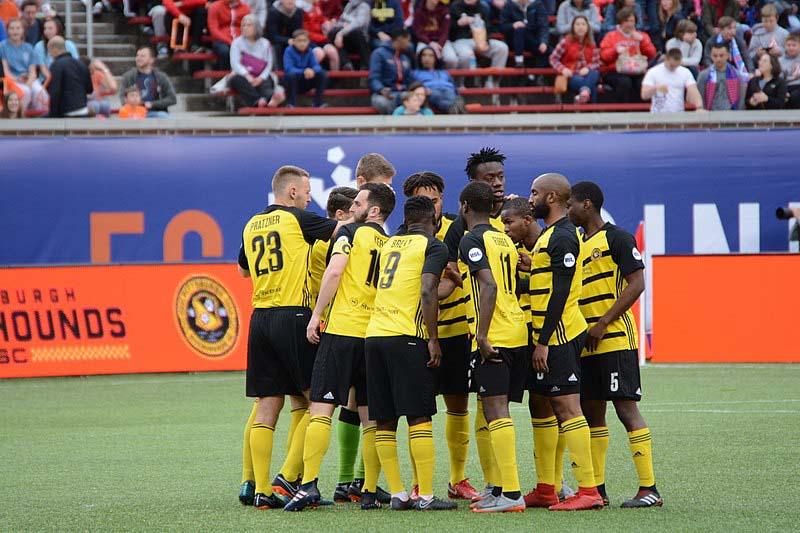Column: Riverhounds could benefit from relegation
Hayden Schiff | Wikimedia Commons
The Pittsburgh Riverhounds are Pittsburgh’s professional soccer team. They will be playing again this Saturday night in the Eastern Conference semifinals — the biggest match in the club’s 20-year history.
October 30, 2019
The Pittsburgh Riverhounds, Pittsburgh’s own professional soccer team, put a dominant 7-0 beatdown on the opposing Birmingham Legion in rainy conditions at Highmark Stadium last Saturday night to advance in the USL Championship playoffs.
The win naturally generated excitement from Pittsburgh’s soccer community, considering the Riverhounds hadn’t won a playoff game since 2004, dropping their last eight opportunities. And after entering the playoffs as the No. 1 seed in the Eastern Conference and with an undefeated record over their last 12 games, the Riverhounds have their eyes set on the championship title.
But all the excitement comes with a sobering stipulation — no matter how far the red-hot Riverhounds advance, they won’t have the chance for upward mobility in America’s soccer pyramid.
This is because the United States’ current soccer system lacks a promotion/relegation aspect, wherein teams move up and down the soccer pyramid based on their performance. The nation’s top league is Major League Soccer, followed by the USLC, where the Riverhounds are, and then other leagues below it.
A good example of the promotion/relegation process can be seen in the English soccer pyramid. In the highest-division, Barclays Premier League, the top six or seven teams at the end of the season qualify for European competition, while the bottom three become relegated to the Championship, the second division in the English soccer table. In the Championship, the top two teams get automatic promotion to the Premier League, while the third through sixth place teams face off in a playoff tournament to see who gets the final spot.
The Riverhounds will play again on Saturday night against Louisville City FC, the reigning champions in the Eastern Conference semifinals. It will be, by far, the biggest match in the Riverhounds’ 20-year history.
If the American soccer pyramid followed similar rules to England, and if the Riverhounds went on to the Championship game and won, they would earn a spot in the next season of the MLS. Even if it used a system where the top teams were promoted based on points in the regular season, Pittsburgh could still advance on the basis of scoring 68 points, third most in the USLC.
Instead, regardless of whether the Riverhounds finish their season with a heartbreaking loss to Louisville or as USLC champions, their fate will remain the same — another season in the same middle tier.
For fans of the Riverhounds, this makes it hard to continuously support the club and professional American soccer in general. Without the dream of a top-league soccer team in Pittsburgh, fans in the area are forced to accept that regardless of how the team does, it will remain in the same league.
The way teams prop up in the MLS is by being accepted into the league. After FC Cincinnati’s addition this year, the MLS has 24 teams, with new teams Inter Miami FC and Nashville SC coming next year and Austin FC in 2021, bringing it up to 27. New teams that have just been announced are St. Louis and Sacramento Republic FC in 2022.
The teams from St. Louis and Sacramento will pay a hefty fee to join the MLS, up to $200 million. Besides the amount of money a future expansion team presents, other factors that are taken into effect are the presence of a good soccer stadium, the size of the metropolitan area and the fanbase.
The problem for the Riverhounds is that while Highmark is in a great location on the Monongahela river and is a soccer-specific stadium, it only seats a maximum of 5,000 people. The next closest usable stadium would be Heinz Field, which has a capacity of 68,400, but without a big enough fanbase, the games would end up having more empty yellow seats than Pitt football games.
The MLS does have valid reasons for wanting to keep the particular model. Having sound investments and an established fanbase from expansion teams is important for keeping a soccer league alive in the United States, especially since it started in 1994 as a 10-team league.
The problem with this model is that it stunts true, grassroots growth of the sport within the country, which was especially highlighted after the embarrassing but deserving failure of the U.S. national team to qualify for the 2018 World Cup. More disgraces have followed, with the team losing to Canada, a country known for hockey and not typically soccer, 2-0 on Oct. 15th.
There are many problems with the national team that are outside of this discussion, but the implementation of a promotion/relegation system would be beneficial in so many ways. It would allow teams from around the country, regardless of size, to make the top league and compete at the highest level.
A relegation system would also increase interest from soccer fans around the country. This would include more than just fans of the Riverhounds, but other fans supporting their team to push for the top of the league or fight from being relegated from that league.
It’s unlikely that we will see changes in the future to this current system, with the amount of money the MLS has invested into how expansion works. Still, the implementation of a promotion/relegation system would benefit soccer fans across the board immensely and would also improve the sport of soccer in America.








